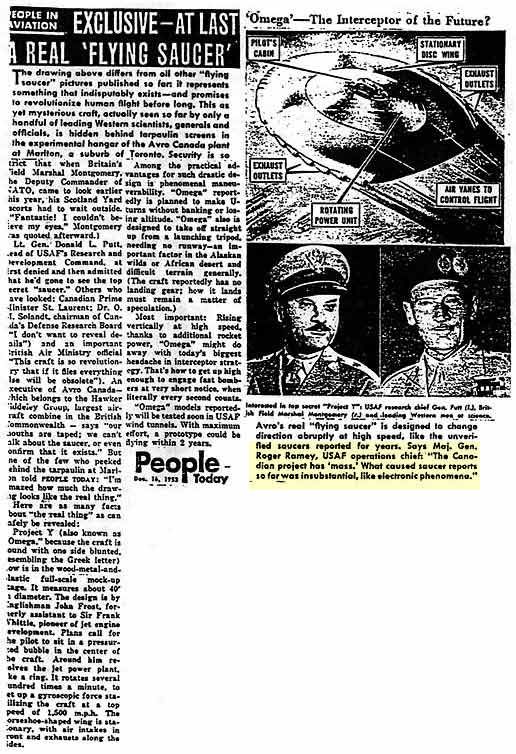Ramey debunking saucers in AVRO saucer article
(also a Lockheed/Skunkworks/Stealth UFO connection)
In the clipping below from December 1953, Gen. Ramey is briefly quoted on the much-hyped AVRO company flying saucer being built in Canada. Ramey basically says that the AVRO saucer was a real craft whereas the reported flying saucers were not, having no more material substance than "electronic phenomena." Ramey had used similar language (no evidence of material existence) when he had been debunking the saucers almost a year and a half earlier during the July 1952, Washington D.C. radar/visual/jet intercept cases.
The proposed supersonic AVRO saucer was supposed to revolutionize aviation. In reality, what was eventually shown to the public in 1959 was far less advanced than had been billed, little more than an unstable ducted fan car that barely got off the ground (photos and history). Some claim the whole AVRO saucer project was a deliberate bit of disinformation to make the public think the saucers were really our craft or Russian. (It is interesting to note, however, that the prototype saucer with its chopped rear end was deliberately modeled after pilot Kenneth Arnold's original 1947 drawing of his "flying saucers," since the head engineeer considered Arnold's report to be authentic.)
The clipping from People Today originally comes from an article by Joel Carpenter first published in IUR (International UFO Reporter). This fascinating article is primarily about a UFO sighting by the famous Lockheed Skunkwork aeronautical engineers and test pilots (that by coincidence occurred the same day as the People Today article, Dec. 16, 1953). The witnesses included the legendary Kelly Johnson, who headed up the teams that built the U.S.'s first jet aircraft and the U-2 and SR-71 spy planes (and also participated in development of the Stealth aircraft). If anybody should have been able to identify an unknown aircraft, these experts should have been able to, but the sighting left them all baffled.
It is also interesting to note that during early development of the Stealth aircraft, the Lockheed engineers were very aware that the saucer shape was the ultimate in low radar observability. In fact, the very first shape tested for its radar stealthiness was a model saucer. Johnson and some of the other engineers actually favored a flying-saucer-like design instead of the "ugly," computer-designed, non-aerodynamic shape of the eventual Stealth aircraft. But like the AVRO saucer, there were also inherent stability problems. Nobody could figure out how to make a saucer shape fly very well. Ben Rich, who headed up the Stealth fighter's development, would later write in his book: "The Martians wouldn't tell us."

